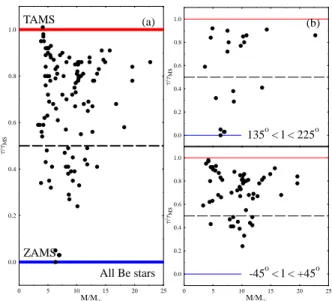HAL Id: hal-00008530
https://hal.archives-ouvertes.fr/hal-00008530
Submitted on 7 Sep 2005
HAL is a multi-disciplinary open access
archive for the deposit and dissemination of
sci-entific research documents, whether they are
pub-lished or not. The documents may come from
teaching and research institutions in France or
abroad, or from public or private research centers.
L’archive ouverte pluridisciplinaire HAL, est
destinée au dépôt et à la diffusion de documents
scientifiques de niveau recherche, publiés ou non,
émanant des établissements d’enseignement et de
recherche français ou étrangers, des laboratoires
publics ou privés.
FAST ROTATION vs. METALLICITY
Ronaldo Levenhagen, Nelson Vani Leister, Juan Zorec, Yves Fremat
To cite this version:
Ronaldo Levenhagen, Nelson Vani Leister, Juan Zorec, Yves Fremat. FAST ROTATION vs.
METAL-LICITY. Societe Francaise d’Astronomie et d’Astrophysique, 2005, France. �hal-00008530�
ccsd-00008530, version 1 - 7 Sep 2005
SF2A 2005
F. Casoli, T. Contini, J.M. Hameury, and L. Pagani (eds)
FAST ROTATION VS. METALLICITY
Levenhagen, R.S.
1, Leister, N.V.
1, Zorec, J.
2and Fr´emat, Y.
3Abstract. Fast rotation seems to be the major factor to trigger the Be
phenomenon. Surface fast rotation can be favored by initial formation con-ditions such as metal abundance. Models of fast rotating atmospheres and evolutionary tracks are used to determine the stellar fundamental parame-ters of 120 Be stars situated in spatially well-separated regions to imply there is between them some gradient of metallicity. We study the effects of the incidence of this gradient on the nature of the studied stars as fast rotators.
1 Introduction
Ste¸pie´n (2002) has shown that magnetic fields can spin up early type stars in the PMS phase. It acts through mass-accretion and magnetic-disc locking, where the efficiency of the interaction can differ according to the content of metals in the star and circumstellar environments. Be stars rotate at Ω/Ωc∼ 0.9 (Fr´emat et al. 2005). It is then expected that the efficiency of magnetic fields at establishing high initial stellar surface rotations can be different according to the metallic content of the medium where they are formed.
2 Method
We study whether there is some incidence of the metallicity on setting the Be phenomenon up by analyzing the age/mass distribution of Be stars situated to-wards the galactic center and in the anti-center direction. The work is based on spectroscopic data obtained with FEROS spectrograph at ESO/La Silla (Chile) and with the Coud´e spectrograph at the 1.60m telescope of MCT/LNA (Brazil). The fundamental parameter determination uses models of rotating stellar interiors and atmospheres according to methods developed in Levenhagen (2004), Fr´emat et al. (2005) and Zorec et al. (2005).
1 Instituto de Astronomia, Geof´ısica e Ciˆencias Atmosf´ericas da Universidade de S˜ao Paulo,
Brazil
2Institut d’Astrophysique de Paris, UMR7095 CNRS, Universit´e Pierre & Marie Curie 3Royal Observatory of Belgium
c
2 SF2A 2005
3 Results and conclusions
Figure 1a shows the distribution of fractional ages (τ /τMS= age/time spent in the
MS) against the stellar mass. Although most of the studied stars lay in the second half of the MS strip, a non negligible number of them is still in the first half of the MS evolutionary phase. A lack of stars below τ /τMS= 0.2 is noticeable. Stars
with masses M ∼ 12M> ⊙ approach the TAMS limit. This may be due to the fast
evolution of massive stars and to the lack of massive Be stars at ages τ /τMS <
∼ 0.5 because of their rapid loss of angular through high mass-loss rates, which convert them into low rotators and disable them to display the Be phenomenon. Figure 1b shows samples of Be stars divided into “galactic-center” and “anti-center” groups. The “center” group outnumbers the “anti-center” one, which is at odds with the announced expectancy. However, the distinction done here is based on the number of Be stars, while the result would be more reliable if we could obtain differences in the fractions of Be/B-type objects in the studied space volumes.
0 5 10 15 20 25 M/M 0.0 0.2 0.4 0.6 0.8 1.0 /MS ZAMS TAMS All Be stars (a) 0 5 10 15 20 25 M/M 0.0 0.2 0.4 0.6 0.8 1.0 /MS -45o< l < +45o 0.0 0.2 0.4 0.6 0.8 1.0 /MS (b) 135o< l < 225o
Fig. 1. (a): Fractional ages τ /τMS against mass of all studied Be stars. (b): Same as
(a), but for Be stars located towards de galactic center and anti-center.
References
Fr´emat, Y., Zorec, J., A.M. Hubert et al. 2005, A&A, 440, 305 Levenhagen, R.S. 2004, PhD Thesis, Univ. Sao Paulo, Brazil
Ste¸pien, K. 2002, A&A, 383, 218
